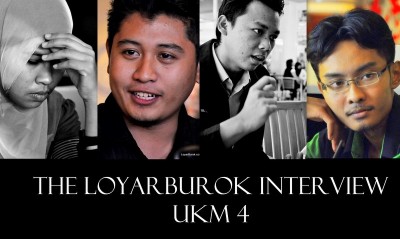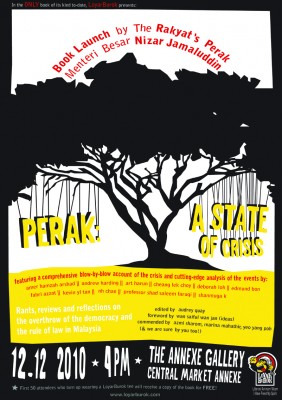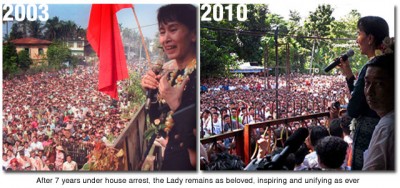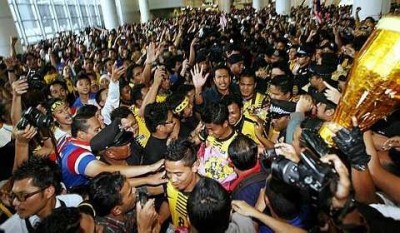As a new year twinkles in the horizon, LoyarBurok casts a collective beady eye at the twelve months that was 2010. The members of the LoyarBurok e-group (which consists of around 170 LoyarBurokkers) came up with their individual Top 10 lists of events or issues which they felt played a key role in 2010. In democratic fashion, a shortlist of 37 items was selected and put to vote by top-secret email ballot.
So then, on the final day of the year, we present to you LoyarBurok’s Top 10 of 2010 (which, in true LoyarBurok style, is actually a Top 12 — three items were tied for tenth spot). The list is presented based on the number of votes received, in descending order (ie. the one with the most votes comes first).

(1) The UKM4 and student activism
In April, four final-year political science students from Universiti Kebangsaan Malaysia (UKM) — Hilman Idham, Woon King Chai, Ismail Aminuddin and Azlin Shafina — were arrested at the Hulu Selangor by-election and charged by their university under Section 15(5)(a) of the University & University Colleges Act 1971 (amendment 2008) (UUCA) for allegedly campaigning in the by-election for local political parties, because of fliers found in their vehicles.
The four filed an application to the KL High Court to declare Section 15(5)(a) of the UUCA 1971 unconstitutional. LoyarBurok highlighted their case in “The UKM 4: Bangkit Mahasiswa!” and thereafter approached the “UKM4” for an exclusive interview to gain an insight into the details of their challenge to this draconian act, which has served as a political tool to quell dissent amongst university students, and to alienate them from the nation building and political processes. The resulting interviews by Ong Jo-Lene, Eunice Ong & Lim Kar Mern were published as “Part 1: Rebels or Revolutionaries?”; “Part 2: Sitting Ducks or Schmucks?”; and “Part 3: Fight for Students Freedom!”
Hilman and King Chai have both started to write for LoyarBurok. A new category — “Stupid Me!” — was launched on this blawg, with a series of articles on student rights. Law students and graduates from UKM (Lingswaran Singh, Hasanuddin Yusof and Tey Jun Ren) and UiTM (Izmil Amri, Azira Aziz and Karl Rafiq) also contributed to LoyarBurok on this issue. The UKM4 recently featured in The New York Times.
(2) 2,000 Orang Asli March to Putrajaya
On 17 March 2010, there was an extraordinary and historic march to the Prime Minister’s by over 2,000 Orang Asli (video by Malaysiakini), who had gathered in Putrajaya to protest against a proposed land bill that, under the guise of granting land, would take away almost 80% of customary land from the Orang Asli. The purpose of the march was to hand over a memorandum signed by 12,000 Orang Asli to the Prime Minister. The memorandum in principle rejects the proposed land bill that was approved without any adequate consultation with the Orang Asli community. As well, it calls for the recognition of Orang Asli customary lands according to the standards outlined by the United Nations Declaration on the Rights of Indigenous Peoples that Malaysia has voted thrice in favour of.
To the Orang Asli, their land is everything, as explained by Tijah Chopil, prominent Orang Asli activist: “Walla teik, walla adat. Walla adat, walla senoi”, which means “Without land, there is no culture. Without culture, there is no people (or nation)”. To date, the Orang Asli are still seeking an opportunity to redress this issue, and for adequate representation for any other government consultations regarding their land rights and other interests made.
(3) Wikileaks
Ahh, Wikileaks, how we love thee. The bane of every government in the world. On their website, it says, “Wikileaks is a non-profit organisation dedicated to bring important news and information to the public.” No shit they did. Established in 2006 by a mixed group of dissidents, journalists and even mathematicians, they gained notoriety in 2010 when they published U.S. State department diplomatic cables. The revelation was so bad when they published the Afghan War Diary and Iraq War Logs that its principal founder, Julian Assange was eventually arrested on, get this, alleged sexual offence (which has absolutely nothing to do with what was published on Wikileaks), which prompted the speculation that it is all politically motivated.
In a way, Wikileaks sparked the debate on freedom of information and speech. While its supporters praised the website for exposing state and corporate secrets, and supporting freedom of press, the U.S. government has labeled the release of its diplomatic cables as “reckless and dangerous”. As the advances in the Internet have allowed for information to flow freely, it remains to be seen what kind of repercussions Wikileaks may bring.

(4) MyConstitution campaign
The MyConstitution campaign is a campaign organised by the Bar Council’s Constitutional Law Committee, and many LoyarBurokkers are heavily involved in it (too many to name here). The objective of the campaign is simple — to increase awareness of the Federal Constitution amongst the rakyat.
The campaign was launched in November 2009, but it was only in 2010 that it really took off. 7 of the 9 campaign phases, pertaining to 9 broad themes of the Constitution, were launched in 2010 by several eminent persons as well as two state-wide launches, and the Mandarin launguage launch of the Rakyat Guide booklets.
Apart from these launches, the campaign also held various workshops, forums and activities throughout the year. The campaign also regularly received media coverage in the form of reports and articles.
The campaign will enter its final stage next year, and is scheduled to end in March 2011. But there are still many more activities in store in the quest to Merakyatkan Perlembagaan.
(5) LGBT & sexuality rights
In 2010, LoyarBurok featured many posts on LGBT and sexuality rights. LoyarBurokker Pang Khee Teik wrote “For Malaysian Gays, Hope For a Better Tomorrow”. Many LoyarBurokkers were also involved in Seksualiti Merdeka 2010 — in fact this year’s Seksualiti Merdeka was launched by LoyarBurokker Edmund Bon. The third annual Seksualiti Merdeka lasted two weeks, and attracted about 1,500 people, including NGOs like the Malaysian Bar Council, UNDP, and Amnesty International Malaysia. Among the highlights were queer anthem concert Rainbow Massacre, Farish Noor’s history of modesty, and a forum theatre piece that was taken to six different private colleges to engage students in discussions about coming out.
To find out more, do read LoyarBurokker Ong Jo-Lene’s “10 Things You Were Too Shy to Ask About Seksualiti Merdeka”. Jo-Lene also interviewed Angela Kuga Thas in “Sexuality Rights is a Human Right”.
Based on the success of the festival, Seksualiti Merdeka undertook the “It Gets Better in Malaysia” project, a series of video messages by adult Malaysians offering hope to young LGBTs around the country who might be going through depression due to the discrimination, loneliness and rejection. The hostility of the discrimination in Malaysia was clearly proven when the public and leaders derided the video by Azwan Ismail, simply because he is a Malay gay man. The video received 240,000 views and 3,500 comments, mostly negative, including threats of violence, stoning and death. It was featured in all the major local dailies and international press (as a result of an interview with AP). At least seven official figures spoke against it, claiming it was “insulting to Islam” and action was to be taken. None of them spoke out against the threats of violence. After two weeks, the video was taken down for Azwan’s safety.
This will no doubt rumble on into 2011, and LoyarBurok will continue to provide an avenue to ventilate views on this issue.

(6) Perak: A State of Crisis
The project that took more than eight months to plan, finally launched! All 1,000 copies of “Perak: A State of Crisis”, LoyarBaca’s maiden book containing a compilation of some of its articles on the Perak constitutional imbroglio (edited by Audrey Quay), have been disposed off, less than a month since its launch (though copies are still available in bookstores and via GerakBudaya). The book attracted many rave reviews, including those by Adrian Chew, Mian Kuan Chen, Izmil Amri, and Dina Zaman. Judge NH Chan, also a contributor, summed it up best:
If we do not want our country to be an oligarchy or to have draconian laws like the ISA to muzzle our freedoms, then read this book and use your vote at the next elections to change all the evil that has befallen us. Don’t forget if it can happen in Perak, it can happen again anywhere in Malaysia.
The intrepid LoyarBurokkers of LoyarBaca (the publication arm of LoyarBurok) have produced a gem of a book. Such an outstanding book has to be a must read. I congratulate them.
Next up is “The LoyarBaca Guide to…” (well, you’ll have to wait and see, won’t you?)
(7) LoyarBurok growth & diversification
This “goddamned blawg” has grown and diversified exponentially in 2010. As was said in Shanmuga Kanesalingam’s welcome speech at the PASOC launch —
“In a short space of time, we number more than 170 members on the LoyarBurokkers egroup, and this community is growing. As an experimental DIY-indie model, the LoyarBurok community is unique because we have relied heavily on social media tools to establish our ties and strengthen our network. Each LoyarBurokker has his or her own field of work, and LoyarBurok provides support (some say inspiration) to them.”
There is now increased awareness of critical issues involving human rights, the administration of justice and the system of governance in our country. Human rights is fast becoming a part of the mainstream, and we see an increased level of activism, with ordinary Malaysians — many of whom were formerly apathetic to these issues — now writing and becoming heavily involved in addressing injustice.
To illustrate this unprecedented growth, since kicking off 2010 with Fahri Azzat’s “Malaysian Police Don’t Know Their Law”, 537 posts were published on this blawg in 2010 (compare this figure to the total of 349 posts in the previous four years since 2006). The posts were by no means limited to black-and-white legal issues, and were of astounding and unforeseen variety. The mantra that “you do not have to be a lawyer to be a LoyarBurokker” is now an undeniable fact.
As 2011 beckons, we invite you come along for the ride. And it’s gonna be one helluva ride!

(8) Aung San Suu Kyi released from house arrest
No one thought that it would happen. But it did. On 13 November 2010, after being under house arrest for more than 15 years, she was finally released.
Aung San Suu Kyi was arbitrarily detained under house arrest following Burma’s general election in 1990. Her party, National League for Democracy had won 59% of the national votes and 81% of the seats in Parliament. Instead of declaring her as the Prime Minister, the junta placed her under house arrest and nullified the election results. Burma has been criticised by many nations and world leaders for their act in continuing to detain Aung San Suu Kyi under house arrest. Some of the criticism even came from ASEAN (Association of South East Asian Nation), of which Burma is a member.
She was a symbol for democracy in a country controlled by the junta. Her release was seen as a major victory for democracy advocates around the world.
(9) Social media awareness, expansion & engagement
In Malaysia, 2010 was undoubtedly the year that Twitter went mainstream. Every major organisation, media outlet, newspaper, radio station and politician appeared on Twitter almost overnight. In fact, it even has a commonly-used name: “Twitterjaya”. The @LoyarBurok Twitter handle became an effective communication tool, and it was noticeable that LoyarBurokkers became increasingly active on Twitter in their individual capacities. The first ever LoyarBorak even asked the question: “Is Twitter Useless at Social Activism?” — do read Part 1 and Part 2 of that borak session between Adrian Chew, Edmund Bon, Marcus van Geyzel, Syahredzan Johan, and Syazwina Saw.
(10) LoyarBurok goes hard print with “Ask Lord Bobo” in the Selangor Times!
With the November launch of the Selangor Times, a free English/Chinese state-government paper which aims to reach out to the community, came LoyarBurok’s first ever venture into hard print, with the weekly column “Ask Lord Bobo”. The column seeks to answer readers’ “questions about everything from law to lawlessness, politics to semantics, relationships to overpriced underwater ships, high-fashion to powerful women with big hair, and other profound, abstruse, erudite, hermetic, recondite, sagacious, and other thesaurus-described queries”. Ask Lord Bobo is edited by Marcus van Geyzel, and written by a team of hardworking, intelligent, and smack-my-spleen-and-call-me-spanky hilarious LoyarBurokkers (in alphabetical order) — Adrian Ng, Adriana Leu, Andrew Teh, Azira Aziz, Edmund Bon, Fahri Azzat, Izmil Amri, June Rubis, Lim Ka Ea, Mian Kuang Chen, Woon King Chai, Puspawati Rosman, Seira Sacha, Shanmuga Kanesalingam, Yap Jin Ru, YM Leow, and Yogeswaran Subramaniam.
If you’ve not been following the weekly “Ask Lord Bobo” columns, what the hell is wrong with you? Oh, and you can read them here (seriously, it will make you smarter, more attractive, confident, get you a payrise, earn you love and adulation, and give your life meaning — or just make you ROFL, or perhaps giggle a little): “Right and Wrong”, “1Malaysia & 8G Mobile Internet”, “Recommended Books & Student Politics”, and “Santa Claus & Glamorous Human Rights Lawyers”.
(11) Death of Aminulrasyid Amzah
When it was reported that the police had shot dead an armed robber, no one really paid attention to the news. Then slowly the details start to emerge. It turns out that the so-called armed robber was a 15-year old teenager, who tried to avoid a police roadblock on his way home in the wee hours of the morning.
The country went into a frenzy, as the police tried to justify their actions in using firearms to apprehend Aminulrasyid and his friend who was with him in the car. The police claimed that they found a parang in the car, which led them to suspect that the two teenagers were on a robbing spree (this was disputed by the deceased’s sister).
A thorough investigation was ordered by the Home Minister. It was reported that the Deputy Minister was asked to “monitor the investigation personally after seeing that the incident had stirred public interest.” The police vowed that there would be no cover-up of the incident. Subsequently, Corporal Jenain Subi was charged with causing Aminulrasyid’s death. The matter went for trial and on 29 December 2010, after calling 39 witnesses, the prosecution closed its case. The matter is now fixed for submissions by both parties on 28 January 2011.

(12) The AFF Suzuki Cup
This item was a late entry, and picked up votes very fast. Not much needs to be written about it really, as it happened so recently. Malaysia won the AFF Suzuki Cup by beating Indonesia over two legs on 26 and 29 December 2010. The victory captured the attention, and hearts of a nation, which for so long had to suffer in the doldrums of footballing mediocrity. As Malaysians gathered to watch in the stadium, mamak stalls, restaurants, bars, public spaces and homes, it brought a joyous, celebratory end to 2010.
There are many cynics, and non-sports fans of course, but one couldn’t help but think and feel — when walking into the Bukit Jalil stadium as early as 1.5 hours before kickoff and seeing a sea of yellow-and-black, and hearing the cheers and roars of 90,000 people in the stadium, and being in the city late into the night and seeing and hearing people cheering, celebrating, tooting their horns — that sport, and football above all sports, has the power to unify the general public like nothing else can.
Roar on, harimau muda!
Items on the shortlist that narrowly missed out included “Coal or no coal?” (The flip-flopping of the coal power plant issue in Sabah throughout 2010), the effect of Chief Justice Tun Zaki Azmi (many feel he has led a worse erosion of the judiciary than that cause by the removal of Tun Salleh Abas in 1988), the Gerakan Mansuhkan ISA vigil at Amcorp Mall, the impoundment of the Bakun dam, Pamela Lim’s infamous “police intimidation” video (which has come to be known simply as “THAT video”), the BP / Deepwater Horizon oil spill, the Federal Court judgment in Malek Hussein, and the awarding of the Nobel Peace Prize to Liu Xiaobo.
Did we miss out anything that was important to you? Sulk, eat a tub of ice cream, scream into a pillow, then settle down and tell us what you think were some of 2010’s most important happenings by leaving a comment below!

Nice piece! Some of mine incl murderer lawyers, and natural disasters more & more in 2010. Iceland, Haiti, plus so many in Indonesia.
hi Lord Bobo, some advise or help on the below situation please? Not only do they take away mental privacy, they also now want to take away our homes as well! Try the below :
Single mum risks losing condo over RM14,000 debt
A single mother of two is in a quandary as she owes the management committee of her condominium RM14,017.20 in outstanding maintenance and sinking fund fees, and interest.
She faces the prospect of having her unit, which she bought for more than RM400,000 three years ago, being auctioned off.
Lisa Nadia Tan Thuan Li, 35, a factory manager, said she could not afford to pay the amount in a lump sum as she has two young children aged four and seven as well as an aged father to support.
“I had issued them 17 postdated cheques for the fees but these were returned to me,” she she told a press conference at Batu Uban assemblyman S. Raveentharan’s service centre on Tuesday night.
She said the quarterly fees were RM734 for the condominium in Gelugor here.
Tan said she had been unable to pay the maintenance charges since Jan 1, 2009.
On Oct 25, the condominium security barred Tan’s car from entering the parking lot due to the outstanding amount.
She responded by parking at one of the condominium’s entrances.
Both sides lodged police reports regarding this incident.
Tan claimed that a large group of people including 10 policemen came to her condominium unit last Sunday at 8.30am.
“The management committee took inventory and photographs up to noon while the police remained outside,” she said.
When contacted for comments, the management committee said: “Please get the comments from our lawyer.”
The lawyer, who declined to be named, said Tan now had 14 days to pay up failing which the condominium unit could be sold through public auction. – By The Star
[[[ *** RESPONSE *** ]]]
This is very wrong and a symbol of all that is bad about modern society. Even at 50% value debt or default, she cannot have her property STOLEN from her. 10% is just too little and unreasonable, even if the S&P states it is legal to do so the unconstitutionality of the S&P renders the contract null and void.
Also note that condos FORCE most buyers to pay maintenance and sinking funds in the S&P. This is unconstitutional and collusion among developers to force people to pay PROTECTION MONEY and could be illegal as it amounts to permanent PROTECTION MONEY scheme by bad developers. Could some good developers please step forth and build condos with good S&Ps that do not demand such unfair terms of the buyers? Little wonder many condos unless in urban areas can stand empty for decades.
A good developer would not appoint a committee nor would it charge sinking or maintenance funds. These are for the BUYERS to do or not do. Typically also, Penthhouses are GIVEN to relatives or cronies as well, who needs to buy IDIOT condos where you effectively come under the mercy of the developer and his crony committees or even THUGS, which in the case of developers being RELATIVES of Assemblymen and MPs who already undemocratically , results is a unconstitutional GANGSTER/Protection Money culture dominated by the developers and politicians who can collaborate to sabotage the poor woman simply because she can't pay 14,000! @Penang fan, MS, SP, ks_rev are obviously in cahoots with someone for talking like that!
If you mean so much ill to your fellow man, forget about them being ignorant anymore. They will counter sue. These abuses by developers and politicians are becoming more evident by the day and we the Rakyat want JUSTICE that Assemblymen and MPs will not give because they are in cahoots, but perhaps higher ups like the Judiciary or Human Rights NGOs could be petitioned to act.
Will a constitutional lawyer or someone with any neutrality (the Istana comes to mind) put their foot down here? You could very well declare her a bankrupt but not take her HOME. The S&P could be considered illegal as it takes a near 2% yearly to maintain. This means in 50 years one would have paid 100% more in value to just live there! This is profiteering at an unimagined level!
Who would want to buy a condo? And based on this developers of landed properties are charging astronomical fees for simple duplexes.
Oppressed Rakyat, rise up against those who would enslave you! Form cooperatives and build your own landed housing projects yourselves, and beware of NGOs also, these supposed saviours are also not truly neutral.
The link to the article follows below Lord Bobo, please help her navigate this mess and tell the developers off for effectively running a protection money scam. This is distressing and you know what they say :
When they came for the socialists
I did not speak out – because I was not a socialist.
Then they came for the opposition politicians
and I did not speak out – because I was not a opposition politicians.
Then they came for the LGBTs
and I did not speak out – because I was not LGBT.
Then they came for the activists
and I did not speak out – because I was not a activist.
Then they came for the trade unionists
and I did not speak out – because I was not a trade unionist.
Then they came for the plutocrats
and I did not speak out – because I was not a plutocrat.
Then they came for the labourers
and I did not speak out – because I was not a labourer.
Then they came for the slum dwellers
and I did not speak out – because I was not a slum dwellers.
Then they came for me –
and by then there was no one left to speak out for me.
Some of us are brimming with free time and wealth and need to move when they can to prevent fascism and dictatorship. Let those evil men count on our laziness and inaction long enough (this may take generations) and they will triumph.
Could someone from Bar Council PLEASE call this woman and offer advice? I tried for your wtiter's post but did not even get a thank you but sorry you're not selected reply. Is Bar Council a real professional body or just another BN lapdog to make the country look civilised?
http://www.apartment-penang.com/2010/12/single-mu…
just wanted to say… 10 or 12? ;) Happy New Year!
12 items! there's always a bonus with loyarburok. happy end of 2010, everyone!